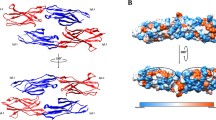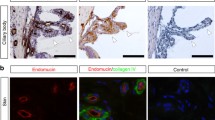Summary
Intercellular adhesion molecule-1, a member of the immunoglobulin supergene family, is the ligand for the integrin lymphocyte function associated antigen-1. Intercellular adhesion molecule-1 and lymphocyte function associated antigen-1 binding interactions mediate leukocyte adherence and migration. Previous work has shown that the adherence of lymphocyte function associated antigen-1 is directed to the first immunoglobulinlike domain of the endothelial cell surface protein intracellular adhesion molecule-1. We have constructed a truncated intercellular adhesion molecule-1 gene encoding the first 185 amino acids from the amino terminus and overexpressed it inEscherichia coli. The recombinant protein was purified from insoluble inclusion bodies and refolded into an active conformation by a denaturation/renaturation cycle. The identity of the protein was confirmed by microsequencing and by Western blot analysis using a polyclonal antibody to ICAM-1. We have demonstrated that this soluble region of the otherwise membrane-bound ligand is an inhibitor of Molt or HL-60 cell adhesion to cytokine-stimulated endothelial cells.
Similar content being viewed by others
References
Adams, D. H.; Hubscher, S. G.; Shaw, J., et al. Intercellular adhesion molecule 1 on liver allografts during rejection. The Lancet, Nov. 11, 1989:1122–1125.
Cosimi, A. B.; Conti, D.; Delmonico, F. L., et al. In vivo effects of monoclonal antibodies to ICAM-1 (CD 54) in nonhuman primates with renal allografts. J. Immunol. 144:4604–4612; 1990.
Crestfield, A. M.; Stein, W. H.; Moore, S. On the preparation of bovine pancreatic ribonuclease A. J. Biol. Chem. 238(2):618–622; 1963.
Diamond, M. S.; Garcia-Aguilar, J.; Bickford, J. K., et al. The I domain is a major recognition site on the leukocyte integrin Mac-1 (CD11b/CD18) for four distinct adhesion ligands. J. Cell Biol. 120(4):1031–1041; 1993.
Dustin, M. L.; Rothlein, R.; Bhan, A. K., et al. Induction by IL-1 and interferon, tissue distribution, biochemistry and function of a natural adherence molecule (ICAM-1). J. Immunol. 137:245–254; 1986.
Giavazzi, R.; Chirivi, R. G. S.; Garofalo, A., et al. The production of soluble ICAM-1 by human tumors grown in vitro and as tumors in nude mice. Proc. Amer. Assoc. Can. Res. vol. 34, #190, 1993.
Griffiths, C. E. M.; Nickoloff, B. J. Keratinocyte intercellular adhesion molecule-1 (ICAM-1) expression precedes dermal T lymphocytic infiltration in allegeric contact dermatitus (Rhus dermatitus). Am. J. Pathol. 135:1045–1053; 1989.
Hale, L. P.; Martin, M. E.; McCollum, D. E., et al. Immunohistologic analysis of the distribution of cell adhesion molecules within the inflammatory synovial microenvironment. Arthritis and Rheumatism 32:22–30; 1989.
Kageshita, T.; Yoshii, A.; Kimura, T., et al. Analysis of expression and soluble form of intercellular adhesion molecule in malignant melanoma. J. Dermatol. 19(11):836–840; 1992.
Laemmli, U. K. Cleavage of structural proteins during the assembly of the head of bacteriophage T4. Nature 227:680–685; 1970.
Leeuwenburg, J. F.; Smeets, E. F.; Neefjes, J. J., et al. E-selectin and intercellular adhesion molecule-1 are released by activated endothelial cellsin vitro. Immunology 77(4):543–549; 1992.
Luscinskas, F. W.; Brock, A. F.; Arnaout, M. A., et al. Endothelial-leukocyte adhesion molecule-1 dependent and leukocyte (CD11/CD18)-dependent mechanism contribute to polymorphonuclear leukocyte adhesion to cytokine-activated human vascular endothelium. J. Immunol. 142:2257–2263; 1989.
Marlin, S. D.; Springer, T. A. Purified intercellular adhesion molecule-1 (ICAM-1) is a ligand for lymphocyte function-associated antigen 1 (LFA-1). Cell 51:813–819; 1987.
Marlin, S. D.; Staunton, D. E.; Springer, T. A., et al. A soluble form of intercellular adhesion molecule-1 inhibits rhinovirus infection. Nature 344:70–72; 1990.
Nickoloff, B. J.; Griffiths, C. E. M.; Barker, J. N. W. N. The role of adhesion molecules, chemotactic factors, and cytokines in inflammatory and neoplastic skin disease—1990 update. Soc. Invest. Derm. 94:151S-157S; 1990.
Prober, J. S.; Gimbrone, M. A., Jr.; Lapierre, L. A., et al. Overlapping patterns of activation of endothelial cells by interleukin 1, tumor necrosis factor and immune interferon. J. Immunol. 137:1893–1896; 1986.
Proudfoot, A. E. I.; Fattah, D.; Kawashima, E., et al. Preparation and characterization of human interleukin-5 expressed in recombinantEscherichia coli. Biochem. J. 270:357–361; 1990.
Rothlein, R.; Czajkowski, M.; O’Neill, M. M., et al. Induction of intercellular adhesion molecule 1 on primary and continuous cell lines by pro-inflammatory cytokines. J. Immunol. 141:1665–1669; 1988.
Sanger, F.; Nicklen, S.; Coulson, A. R. DNA sequencing with chain terminating inhibitors. Proc. Natl. Acad. Sci. USA 74:5463–5467; 1977.
Staunton, D. E.; Dustin, M. L.; Erickson, H. P., et al. The arrangement of the immunoglobulin-like domains of ICAM-1 and the binding sites for LFA-1 and rhinovirus. Cell 61:243–254; 1990.
Studier, F. W.; Rosenburg, A. H.; Dunn, J. J., et al. Use of T7 RNA polymerase to direct the expression of cloned genes. Methods Enzymol. 185:60–89; 1990.
Author information
Authors and Affiliations
Rights and permissions
About this article
Cite this article
Ross, L., Davis, C.M. & Molony, L. A truncated recombinant intercellular adhesion molecule-1 inhibits adhesion of leukemic cell lines to upregulated endothelial cells. In Vitro Cell Dev Biol - Animal 30, 875–880 (1994). https://doi.org/10.1007/BF02639398
Received:
Accepted:
Issue Date:
DOI: https://doi.org/10.1007/BF02639398




